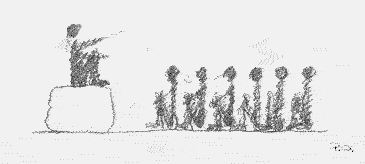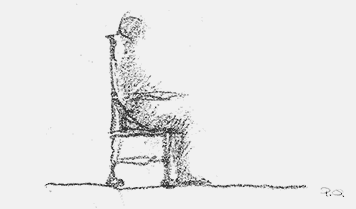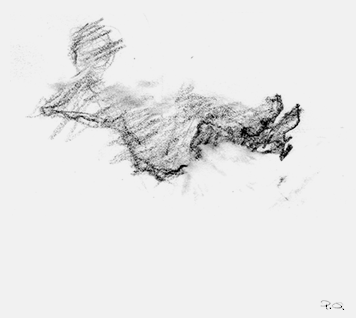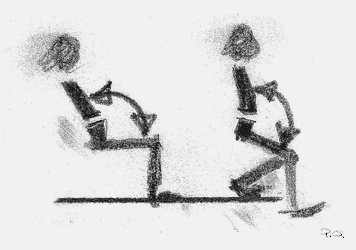Chairs or sitting devices are standard pieces of equipment in most societies. Formed according to the established standards, based on the “accepted western manner of sitting”.
When the various authorities in ergonomics were all promoting their one and only “correct” sitting posture, my comment was that all of them were right!
All of the recommended sitting postures were good, and I saw it as my job to design chairs that allowed as many different comfortable postures as possible and to make it easy to move and change frequently between them. The best sitting posture is always the next.
Explore my dynamic tilting concepts and backdrop below.
The balanced tilt

The seat and the back of the chair are joined to form what can be called the body of the chair. This inspire the user to tilt freely from a forward-leaning position to a reclined position by tilting over a pivot point or axis under the seat right at the body's very centre of gravity. The front of the seat moves up and down when the chair tilts back and forth, thus the position of the feet controls the tilt angle of the chair.
There are many names to describe this concept: Balanced tilt, Floating tilt, Balanced Movement Mechanism and the trademark Flokk uses on my dynamic chairs: InBalance.
The Wheel

In chairs with rollers or runners, it is the runners' contact with the floor that constitutes the tilting point. Imagine placing a person inside a wheel, and that this person changes position. The wheel or the ball has an exceptional quality that when rolling on a flat surface, it always comes to rest in a balanced position. However, in this case the wheel is not circular; rather it has a curve designed for both stability and motion. This is one of the simplest ways of creating tilting in a chair.
Spiral springs

Our legs and feet have the main responsibility for moving us in almost all situations. It therefore seems only natural to me to make tilting concepts that enable the feet to continue to perform this task also while we are sitting in a chair. They are our experts in movement.
Suspended from above

In this concept chairs or support surfaces are suspended with ropes, from above. What is it that fascinates us about sitting on a swing? It gives us a sense of freedom. No other kind of seat allows us such freedom of movement as one suspended from ropes.
A pendulum clock can keep going for weeks on the small amount of force generated by the spring, proving the efficacy of this principle. The movements of suspended bodies are soft and rhythmical, soothing to mind and body alike. It is particularly difficult to sit still. Perhaps such movements spark associations with the time when we floated effortlessly in the womb?
In this concept I have found a device that helps the user to move naturall.
Our active past
In Stone Age societies, people led physically active lives. In contemporary nomadic societies they still do.
The physical labour necessary to produce food required varied use of limbs and muscles.
Our passive present
Recently, across large parts of the globe, lifestyles have changed radically.
We have suddenly become more passive, and hard physical toil is no longer essential to our survival.
Post-industrial societies

Physical mobility began to decrease with the advent of industrialized and subsequently post-industrialized societies. We move less as our work is often stationary and involves repeating the same movement, for hours on end, day after day.
Staring at a screen is a relatively new activity. First there was the television screen, then the computer screen, and now the portable laptops and mobile phones follow us everywhere. An increasing proportion of the population is now much less active than just a few decades ago.
Tools

The transition to extensive use of tools does not always lead to a better existence It is probably better for our health to walk than to drive a car. It may be more natural for the human body to deliver a message in person than to use the various forms of transmission that began with a chisel and rock, and has culminated in extensive SMS and twitter messages.
Whether we use two stones to grind corn, or we “grind” using the computer mouse, it amounts to the same thing. The only difference is that different parts of our body are affected. Being a designer I need to focus on what the tools do to us as well as what they do for us.
Sitting postures

Throughout history, sitting positions, or the way we have placed our limbs while sitting, have varied from period to period, culture to culture, and continent to continent.
Sitting on a seat - the message of language

In many languages, the verb "to sit" also signifies holding a position of power.
Expressions such as a "the sitting bishop", "chairman", “parliamentary seats”, and “to chair a meeting" all refer to social status and powerful positions.
These examples suggest that sitting postures and sitting traditions relate as much to social circumstances as to needs for physical support.
The Chair and the authority

Status and authority were the primary functional requirements for the first "chair", and for the further refinement of sitting devices.
The industrial revolution and social mobility

In the nineteenth century the major changes entailed by industrialisation led to chairs becoming a standard piece of equipment in the workplace, schools and private homes.
It is clear that the factory worker's and the office worker's work chairs were based on the accepted way of sitting in the upper echelons of society.
.
Learning from the first long-term sitters

Modern society has made us sit on chairs to get our work done. The sitting position has historical roots based on selected social and cultural ideals. How might things have been different if we had turned to history to learn from earlier eras' "long-term sitters"?
Riders must be among the earliest long-term sitters and they always sit with a good posture and a well balanced upper body. The stirrup ensured good (foot) control whilst moving with the horse. However, the saddle was not a source of inspiration when chairs where designed for factory workers.
Rituals - the solution to an ergonomic problem?

Church rituals were developed where worshippers had to alternate between different positions and thus get the movement and variation necessary to get through the long service: standing up to sing, kneeling down to pray.
When I was a child, we had to stand up when the teacher entered the room, when we were asked about our homework and when we had to recite a poem, read something aloud or sing.
This traditional alternation bears witness to the fact that the need for a variety of movement and changes in bodily posture was widely understood in the past, and indeed up until quite recently.
How functional was functionalism?

As far as furniture for sitting is concerned, there are grounds to query whether the twentieth century's functionalism really did lead to more functional solutions for the user – the sitting human being.
The new pieces got rid of a lot of unnecessary ornamentation and detail, and they certainly became simpler to manufacture and easier to clean. However, the basic concept of sitting was not subject to review. With a few notable exceptions, the focus was not on the needs of the human body while sitting.
In this sense, most of the furniture produced in the functional era was not more functional than the styles it replaced.
Freedom of movement and variation of posture
If we accept that we have become a sitting society, what solutions can there be to the challenges of todays static and passive lifestyle?
Two obvious solutions spring to mind:
- To spend less time in a sitting position
- To move and to vary our postures while sitting
Although the first solution is clearly preferable, it is only the second one that I have any capacity
to influence in my profession by developing chairs and sitting devices.
Balance
Movement

Which arm will get tired first?
If standing still were the most comfortable position, people waiting for a train would look like statues. But they don't, they choose movement.
Whenever we can, we simply prefer to move. The movements may be miniscule, such as a slight swaying from foot to foot, or we may choose to pace back and forth. This preferene for movement also applies when we are sitting.
The only condition in which a human being is completely still is death.
Variation of postures

Isn't it a luxury to be able to stay put in our favourite position for an hour or two? No, because even the most comfortable position in the most comfortable bed becomes uncomfortable after a while. This general human need for variation also applies for sitting.
Even the most "correct" way of sitting recommended by the most prominent experts becomes uncomfortable after a while.
Formal – Private

Imagine that you are the guest of honour at some kind of formal, official ceremony and have to sit on a chair on stage in full view of everyone. How would you sit?
Then, when you get home after the reception and you are alone, you draw the curtains and lock the door. You pick up the newspaper and sit down. What kind of sitting posture would you adopt now? The chances are that you would arrange your limbs in an “uncivilized” manner, one that feels good to you.
Bodily impulses and physical obstacles

“The best posture may be the next one.”
After a while the pilot wish to stretch out and the carpenter would like to recline.
“Floors” of different heights
Placing the desktop at a height for standing work makes it possible to build “floors” at different levels. Whether in a forward-leaning or backward-leaning posture, with this concept, the user will automatically move his feet alternately between the different support levels while working.
What provides most variation? To adjust the desk top up or down a few times a day or to alternate between different floor heights several times a minute?
Surroundings

The human body is soft and dynamic, whereas the buildings or structures we have built for ourselves have to be hard and static so as not to collapse.
First, we can start by questioning how close to the body we want this transition of the surroundings from the dynamic to the static to take place.
The body is flexible, and we like our clothes to be flexible too. However, outside our clothes, most of us spend a lot of time "wearing" a chair of some sort.
What I am suggesting is that the chairs we "wear" for long periods of time should be neither as soft and flexible as our clothes, nor as hard and inflexible as our buildings; rather, the chair should work as an intermediary between the dynamic body and our static architectural surroundings.
Oscillations

Humans follow certain rhythms, oscillations or intervals. Intervals of activity and rest constitute one example of an inherent biorhythm. Ideally, during all our various activities, we should constantly be alternating between actively using our muscles and relaxing them.
Can the shape of our sitting devices contribute to achieving this?
Perequisite for dynamic sitting
Beeing in balance, as opposed to being supported out of balance is the best starting point for making a movement, for example, taking a step or making a jump. Being well balanced is a prerequisite for effortless movement. If we want our entire bodies to be in balance in a sitting posture, chairs must be designed expressly for this purpose.
Foot control
Our legs and feet have the main responsibility for moving us in almost all situations. It therefore seems only natural to me to make tilting concepts that enable the feet to continue to perform this task also while we are sitting in a chair. They are our experts in movement.
The feet, the ignored extremities in Ergonomics

Ergonomists, however, when addressing chairs and sitting, have tended to be primarily concerned with the upper parts of the body: the back, neck, shoulder and arm. But the feet are vital in Dynamic Ergonomics and in my dynamic chairs, the feet control the tilt angle, which inspires the feet to constantly change position.
What is your favourite postures?
Each part of the body has its favourite positions, but exactly which one is preferred at any given time is dependent on the positions the other parts of the body have assumed.
The extent to which bodily parts can have their “desires” fulfilled depends on freedom of mobility and opportunities for support.
The feet

When sitting on the floor to have a meal in a Japanese restaurant, the main problem is what to do with our legs. The main functional reason that we sit on elevated levels, stools or chairs is undoubtedly that it allows our legs and feet freedom on a lower level than the one at which we are sitting.
Each of the angles or positions our upper body assumes when we sit has its appurtenant “favourite positions” for the legs.
When we rest our upper bodies in a reclined position, we want to have our feet raised. When we are active, leaning our upper bodies over a table, we want our feet low.
(PDF)
.
The torso or middle regions

The human musculoskeletal system (also known as the locomotive system) is made up of soft tissue and bones. Our ability to move is due to these bones being connected by joints. When we move the body into the traditional sitting posture with the hips, knees and ankles all bent at 90-degree angles. Our ankles and knees are quite happy to bend to a 90 degrees angle. However, the hip joint stops bending after approximately 60 degrees and we make up the remaining degrees by straightening the curvature of the spine
A steep downward slope for the thighs (approximately 60 degrees angle in the hip) means that it is easier to retain the natural favourite curvature of the lumbar region.
The upper body is generally most comfortable when we are standing, so it is safe to assume that this upright posture ought to be the upper body’s favourite position, also when we are sitting. A prerequisite is that the lower body provides a good “open angle” permitting this posture.
What posture does the upper body prefer when we sit on a normal dining room chair? One thing is certain: we seldom sit with the upper body in conformity with the backrest angle that is typical for this type of chair. Reclining and leaning forward over the table is the two favourites.
(PDF)
Arms and hands

When we sit, we try instinctively to find a place to put our arms, and if we don’t find another place, we rest our arms on our laps. If we are sitting in a chair, there are more options, and if the chair has armrests these are of course a natural place to find support.
We like to have the support vertically beneath our shoulders, and this means that when we rest our forearms on the tabletop, this is not only to give our arms a break; it also takes body weight off the back..
(PDF)
The head

We sometimes feel the need to support our head. My solution is to make sure that there is a gap between the backrest and headrest to allow the shoulders freedom of movement. Just as pauses are important in music, gaps can be as important in furniture. When the backrest tilts, it does not simultaneously affect the position of the head rest.
This means you can retain the support for the lower back while at the same time getting full support for the head.
A space between the back and head support allows the user to sit sideways and use the top of the backrest as an armrest, and enjoy the same freedom as in a low-backed chair. The user is not limited to face forwards when sitting, as is the case in conventional high-back work chairs.
(PDF)
Chair profiles

Four body postures and three chair profiles.
Which of these three chair profiles provides the best support in all four postures?
The convex, the straight, or the concave seat and backrest profile?
(PDF)